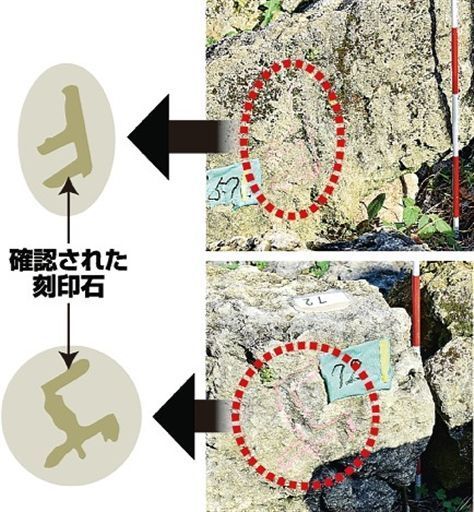Mysterious symbols found engraved in stones in newly discovered castle wall at Nakagusuku Castle Ruins

Seal stones bearing engraved symbols resembling the letter “F” and a Buddhist swastika discovered at Nakagusuku Castle Ruins
February 3, 2019 Ryukyu Shimpo
By Kazuya Arakaki
[Nakagusuku] The Nakagusuku Board of Education (BoE) disclosed on February 2 that during their survey of the newly discovered castle wall at Nakagusuku Castle Ruins, the discovered symbols such as letters that resemble an “F” and an “L” and Buddhist swastikas in the stone used to construct the wall.
The marks appear to be “seal stones” carved when the wall was constructed.
Similar seal stones have been found at Shuri Castle, also in Okinawa, making this the second such discovery.
Literature and folklore related to these seal stones are lacking, so the meaning of these symbols are unknown.
Experts indicate that the symbols may serve as instructions for the fortification process during construction at Nakagusuku.
This discovery is being hailed as having significant influence on Okinawan castle research.
These seal stones were discovered during the dismantling of an early 15th-century castle wall as part of ongoing castle repairs.
As of the writing of this article, 30 such stones have been confirmed, however there is the possibility that more will be discovered.
It is thought that the symbols could be a mark for use during construction, or even a mark placed by masons indicating for what the stone was intended.
Outside of Okinawa, there have been examples at Edo and Osaka castles of stones with engraved Daimyo family crests as well as engraved construction symbols.
At Shuri Castle, there were also symbols that resemble an “H” or a “+” found at Kyukeimon’s eastern wall, although their meaning or purpose is also unknown.
The Nakagusuku BoE is making a record of the measurements and characteristics of each stone being removed, and the plan is to then analyze the variations in the engraved symbols.
The castle wall will be measured by laser and digitalized, and the regularity of the placement of these seal stones will be studied.
(English translation by T&CT and Sam Grieb)
Previous Article:Central government considers Henoko seafloor reinforcement method using 60,000 sand pillars
Next Article:Okinawa fails to surpass Hawaii in terms of 2018 tourist numbers and increase rate
[Similar Articles]
- Early 14th century castle wall discovered at Nakagusuku Castle, predating previously accepted historical timelines
- Nakagusuku and Katsuren castle ruins rank among Japan’s best 20 castles
- Human bones and stone tools dating back 12000 years found in Nanjo
- Madama-michi Road from 16th century excavated around Shurei gate
- World Heritage site Nakijin Castle wall collapses due to Typhoon Number Seven
 Webcam(Kokusai Street)
Webcam(Kokusai Street)


